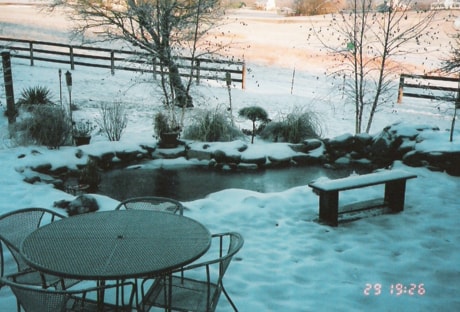Waterfalls, fountains, birdbaths, tubs, ponds and streams are the popular water features in Central Alberta.
During the summer months they add colour, sound and attract wild visitors to the garden.
As winter approaches these water features must be prepared for the cold weather.
Only the larger ponds can be left undisturbed as the seasons change.
Smaller, portable water features should be drained and stored inside.
Pipes of permanent features need to be drained or blown out with compressed air. Water that is left in the pipes over winter will freeze and expand causing the pipes to break or split.
Water that is left in the pond basin will freeze over. The smaller and shallower the pond, the quicker it will freeze.
Hardy waterlilies and many of the native water plants will overwinter on the bottom of a pond if their roots don’t freeze.
The depth of ice on a pond depends on temperature and snowfall, but usually plants on the bottom of a pond with a depth of four to five feet (1.2 to1.5 metres) deep will overwinter.
Plants in shallower ponds can be removed from the water after the foliage freezes down and placed in a dark plastic bag, then placed in a cold room or a cool corner of the basement or garage.
Check the plant periodically over the winter to ensure the root is still moist and the plant is still dormant. Once the ice melts next spring the plants can be fertilized and placed back in the pond.
Hardy marginal plants, the ones that live on the edges, should be left intact until next spring. Removing the top growth in the fall runs the risk of letting water into the centre of the plant which will cause it to rot.
Hardy floating plants will slowly sink to the protection of the bottom of the pond to emerge again in the spring.
Tropical plants do not survive the Alberta winter outside. Plants that are inexpensive such as water lettuce and water hynthins are often treated as annuals. They are discarded every fall and new ones are purchased each spring. The alternative is to keep them in a tub of water with strong sunlight.
Water emergent plants can be overwintered similar to the hardy waterlily.
Remove the plants from the pond, remove the top growth and place the roots in a dark plastic bag. They will stay dormant if they are kept in a cool area and not allowed to freeze.
Tropical waterlilies should be removed from the pond placed in a tub of water and placed in a cool location with dull light. Fish can be removed from small ponds and kept indoors during the winter months.
An alternative is to keep a hole in the ice all winter. This can be accomplished by using a floating pond de-icer. The heated appliance will float in the pond keeping a small area open to allow the toxic gasses to escape.
A pond aerator is another method of overwintering fish outdoors. It works by supplying oxygen to the pond while helping keep the pond open.
A third method is to insulate the top of the pond and keep an aeration hole open with a submergible aquarium heater and an aquarium pump.
The water in a pond will cool quickly at this time of year. Winterizing the pond can be a very miserable job if left until late in the season.
Linda Tomlinson is a horticulturalist and educator living in Rocky Mountain House. You can contact her at your_garden@hotmail.com
